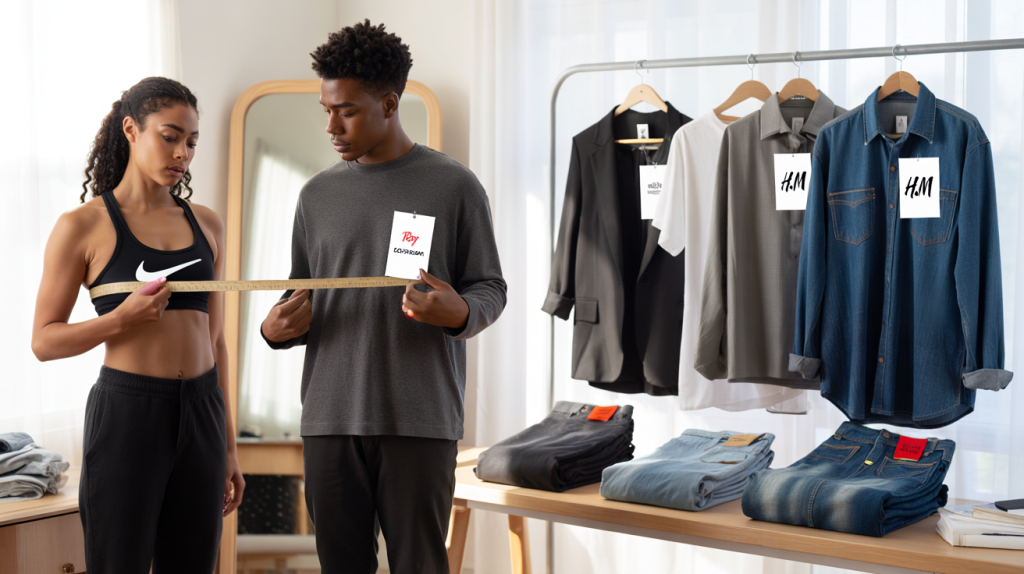Clicking buy should not feel like roulette. Sizing jumps between brands, cuts, and regions – and it shows at checkout. Narvar’s “State of Returns 2022” reported that 42% of online returns came from fit issues. So yes, picking the right size is the real win.
The fix starts with one thing: reading brand size guides the way brands intend. Nike, Zara, H and M, Uniqlo and Levi’s do not measure garments the same way and they do not label fits the same. A clear method helps cross that gap fast, before the cart fills up with items that come back.
Why sizes swing by brand and how to work around it
Each label cuts for its own fit block. That base pattern decides shoulder slope, rise, thigh ease, sleeve head. Switch brand – the block changes, the size changes. Then come regional labels. US letters, EU numbers, UK oddities. The same body, three tags, three meanings.
Standards exist, but adoption varies. ISO 8559-2:2017 defines how to take body measurements for clothing. It has helped teams align their charts, not fully unify them. So the practical move is simple: measure the body, compare to each brand’s body-based chart, then double-check garment measurements if the page lists them.
Quick brand-by-brand fit notes you can use today
Nike leans athletic. Many tops follow a slim or standard block, and performance ranges sit closer to the body for moisture control. On product pages, check the “Standard”, “Slim” or “Loose” tag – it signals ease far better than S or M ever will.
Zara mixes fashion-forward cuts with fast turns of season. Expect narrower shoulders in tailored pieces and variable ease in denim. The site often offers a size recommendation tool using height, weight and fit preference. Use it as a hint, not a rule.
H and M updated womenswear sizing in the UK in May 2018 after customer feedback on small fits, a change acknowledged in media at the time, including the BBC. Since then, basics tend to read closer to “true to size”, while Trend lines can feel tighter.
Uniqlo publishes clean, metric-first charts and, crucially, garment measurements for many items. That single detail makes a difference when a boxy tee or an oversized shirt enters the cart. Compare a favorite piece at home to Uniqlo’s flat measurements and the guesswork drops.
Levi’s lives by fabric and finish. Rigid denim behaves differently than stretch. For 501 Shrink-to-Fit, Levi Strauss and Co. explains that jeans will shrink after the first wash – typically about 1 inch at the waist and 2 to 3 inches in length – and recommends sizing accordingly on its fit guidance. Pre-shrunk models will not move like that.
Read any size chart like a pro, step by step
Body vs garment – start there. A body chart expects tape-measure numbers from your body. A garment chart lists finished measurements of the item. Mixing the two creates mistakes.
Measure once, correctly. Tape snug, never tight. Bust or chest at fullest point, natural waist at the crease when bending, hips around the fullest part, inseam from crotch to the floor with a hardback book as a marker. Write everything down.
If a page lists garment measurements, compare those to a similar piece you already own. Lay it flat, measure width, then double it for the circumference. That match is the safest predictor of fit in real life.
- Match your body measurements to the brand’s body chart, then cross-check with garment measurements when available for your exact fit preference.
Shrink, stretch, and ease matter. Cotton jersey can relax after wear. Wool knits can bloom. Rigid denim will settle with creases. Read fabric composition and care labels straight away to predict changes after the first wash.
Essential measurements and conversions, with sources
Centimeters keep precision. One inch equals exactly 2.54 cm according to the National Institute of Standards and Technology. If a chart only shows inches, multiply by 2.54 to switch to cm. If you prefer inches, divide cm by 2.54. Quick, clean, repeatable.
When brands reference standards, that is good news. ISO 8559-2:2017 sets definitions for body points like high hip, shoulder point, and crotch depth, which reduces ambiguity between charts. Seeing ISO mentioned on a brand’s technical page signals better measurement discipline.
On returns and fit frustration, the data aligns with daily experience. Narvar’s “State of Returns 2022” found fit-related issues at 42% of returns. That number has nudged retailers to add garment measurements, on-model size notes, and size-recommendation tools. Not perfect, but trending useful.
Denim is the classic outlier, so one extra lens helps. Levi’s guidance for 501 Shrink-to-Fit has long suggested accounting for shrinkage – roughly 1 inch at the waist and 2 to 3 inches in inseam after the first hot wash – documented on Levi’s product and fit pages. Rinse-washed or pre-shrunk models will not behave that way, so do not apply STF rules there.
One last detail closes the loop. If the brand lists “ease” or labels fit as “Relaxed 6 cm at chest” or “Slim 2 cm at thigh”, treat that number as the gap between body and garment. Choose more ease for layering or airflow, less ease for a closer silhouette. Then hit buy and recieve what was expected.
